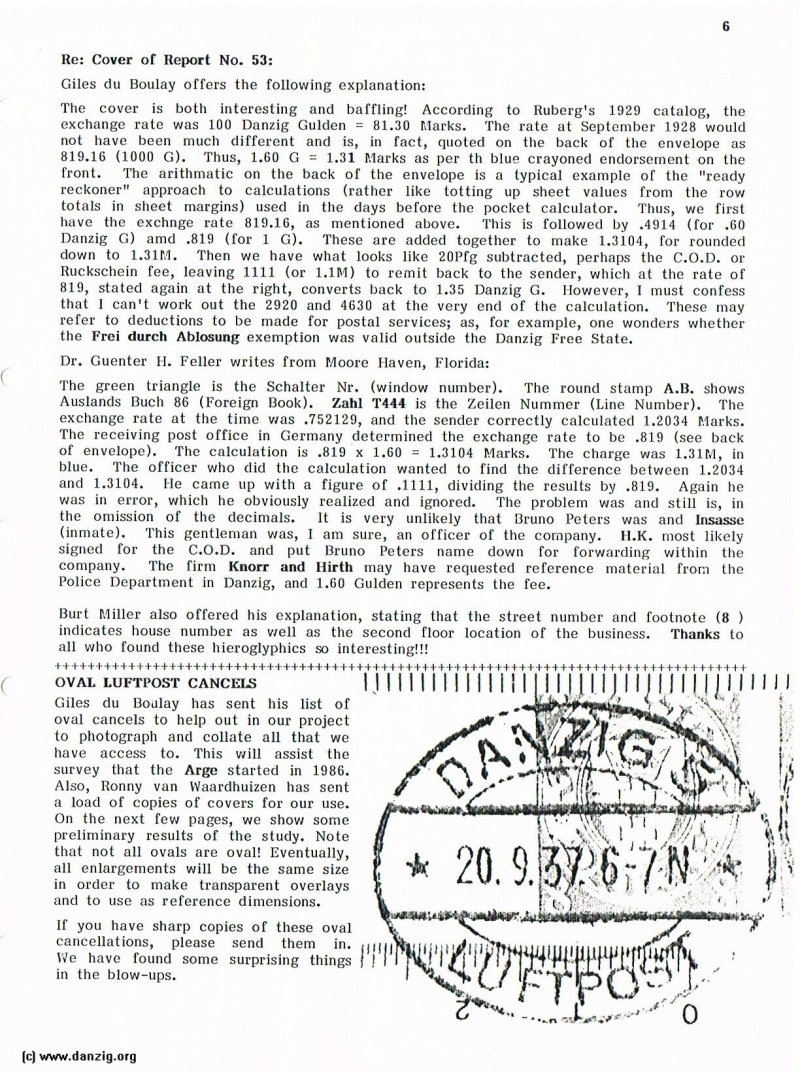
Re: Cover of Report No. 53:
Giles du Boulay offers the following explanation:
The cover is both interesting and baffling! According to Ruberg’s 1929 catalog, the exchange rate was 100 Danzig Gulden = 81.30 Marks. The rate at September 1928 would not have been much different and is, in fact, quoted on the back of the envelope as 819.16 (1000 G). Thus, 1.60 G = 1.31 Marks as per th blue crayonecl endorsement Ofl the front. The arithmatic on the back of the envelope is a typical example of the “ready reckoner” approach to calculations (rather like totting up sheet values from the row totals in sheet margins) used in the days before the pocket calculator. Thus, we first have the exchnge rate 819.16, as mentioned above. This is followed by .4914 (for .60 Danzig 0) amd .819 (for 1 G). These are added together to make 1.3104, for rounded clown to 1.31M. Then we have what looks like 2OPfg subtracted, perhaps the C.O.l). or Ruckschein fee, leaving 1111 (or 1.1M) to remit back to the sender, which at the rate of 819, stated again at the right, converts back to 1.35 Danzig 0. However, I must confess that I can’t work out the 2920 and 4630 at the very end of the calculation. These may refer to deductions to be made for postal services; as, for example, one wonders whether the Frei durch Ablosung exemption was valid outside the Danzig Free State.
Dr. Guenter I-I. Feller writes from Moore Haven, Florida:
The green triangle is the Schalter Nr. (window nuLnber). The round stamp A.B. shows Auslands I3uch 86 (Foreign Book). Zahi T444 is the Zeilen Nummer (Line Number). The exchange rate at the time was .752129, and the sender correctly calculated 1.2034 Marks. The receiving post office in Germany determined the exchange rate to be .819 (see back of envelope). The calculation is .819 x 1.60 = 1.3104 Marks. ‘I’he charge was 1.31M, in blue. The officer who did the calculation wanted to find the difference between 1.2034 and 1.3104. He came up with a figure of .1111, dividing the results by .819. Again he was in error, which he obviously realized and ignored. The problem was and still is, in the omission of the decimals. It is very unlikely that l3runo Peters was and Insasse (inmate). This gentleman was, I am sure, an officer of the company. u.K. most likely signed for the C.O.D. and put Bruno Peters name down for forwarding within the company. The firm Knorr and Hirth may have requested reference material from the Police Department in Danzig, and 1.60 Gulden represents the fee.
Burt Miller also offered his explanation, stating that the street number and footnote (8
indicates house number as well as the second floor location of the business. Thanks to all who found these hieroglyphics so interesting!!!
OVAL LUFTPOST CANCELS
Giles du 13o,ilay has sent his list of oval cancels to help out in our project to photograph and collate all that we have access to. This will assist the survey that the Arge started in 1986. Also, Ronny van Waardhuizen has sent a load of copies of covers for our use. On the next few pages, we show some preliminary results of the study. Note that not all ovals are oval! Eventually, all enlargements will be the same size in order to make transparent overlays and to use as reference dimensions.
If you have sharp copies of these oval cancellations, please send them in. We have found some surprising things in the blow-ups.
Danzig Report Vol. 1 - Nr. 54 - January - February - March - 1987, Page 6.
Hits: 1806
Added: 21/06/2015
Copyright: 2024 Danzig.org

